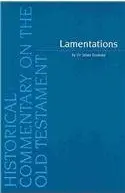

Lamentations
in Historical Commentary on the Old Testament
Pages
641 pages
Publisher
Peeters
Published
7/31/1999
ISBN-13
9789042906778
The Historical Commentary on the Old Testament is an international series of commentaries which devotes explicit attention to the history of interpretation of biblical tradition in all its stages, both within and without the Hebrew canon. The commentary stands in the Christian exegetical tradition. In Lamentations the treatment of every pericope is preceded by a new translation and a section called "Essentials and Perspectives" in which the author summarizes the results of the exegesis in non-technical language. The present commentary on Lamentations distinguishes itself by the fact that it is clearly and explicitly based on the songs understood as an interactive unity, one in which it would appear that the songs provide comment and explanation on one another. The result is a commentary full of exegetical surprises which frequently departs from the traditional.
Collections
This book appears in the following featured collections.
- Favorite Advanced OT Commentaries by Jeremy Pierce (parableman)
Reviews
This commentary on Lamentations leaves all the other commentaries on the book in the dust. For thoroughness, yet retaining the big picture, this commentary has no equals on Lamentations. It is simply the best commentary on Lamentations. Knowledge of Hebrew is necessary, as it is a very technical commentary. Furthermore, reading critically is also necessary, since the author, while not as liberal as many, does have some liberal tendencies. Fortunately, they do not make themselves apparent very much in this commentary. It is essential reading.
Leuven: Peeters, 1998. Pp. 641, Cloth, No Price Available, ISBN 9042906774. Charles William Miller University of North Dakota Grand Forks, ND 58202 This newly translated (from the Dutch) commentary is a welcome addition to the Historical Commentary on the Old Testament series. The book begins with a relatively brief introduction (pp. 33-71) that discusses issues of title, canon, literary structure, authorship, date, place of origin, and theology. Renkema includes a separate section where he outlines his approach to method (pp. 72-79), much of which will be familiar to those who have read his previously published essays and articles on Lamentations. The remainder of the commentary is divided into five sections corresponding to the five chapters, or poems, of the book. Renkema's discussion of each poem follows a set pattern: translation, literary structure, a nontechnical overview of the poem designed for a general audience, and, finally, a highly detailed "Scholarly Exposition" of the poem itself. Much of the introductory materials adheres to mainstream scholarship and is rooted in traditional historical-critical approaches, as one would expect in this commentary series. After brief comments on the book's title and its canonical status, Renkema turns to what is perhaps the most distinctive part of his introduction–the section entitled "Literary Structure." It is here that he discusses the unity and genre of Lamentations. Renkema states that the book is "no doubt . . . a written creation, a well considered compositional unity" (p. 44). Renkema is certainly not the only scholar who argues for the unity of Lamentations, although, among contemporary scholars, one is hard pressed to find more than a handful. According to Renkema, it is the alphabetic character of the five poems (chapters 1 through 4 being acrostics and chapter 5 having 22 verses) that argues for the book's unity. Each strophe of a poem is related to the corresponding strophes in all the other poems. The alef-strophe in chapters 1 through 4 and the first verse of chapter 5, for example, are linked at the semantic level across the entire book. This is true for the bet-strophe, the gimel-strophe, and so on. These external parallelisms afford "a clear literary indication for the mutually respondent character of the songs" (p. 50), which in turn suggests, at least to Renkema, that these song responses make "quite evident" the unity of Lamentations (p. 76).
[Full Review]

